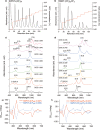Selective emergence of photoluminescence at telecommunication wavelengths from cyclic perfluoroalkylated carbon nanotubes
- PMID: 37524908
- PMCID: PMC10390534
- DOI: 10.1038/s42004-023-00950-1
Selective emergence of photoluminescence at telecommunication wavelengths from cyclic perfluoroalkylated carbon nanotubes
Abstract
Chemical functionalisation of semiconducting single-walled carbon nanotubes (SWNTs) can tune their local band gaps to induce near-infrared (NIR) photoluminescence (PL). However, tuning the PL to telecommunication wavelengths (>1300 nm) remains challenging. The selective emergence of NIR PL at the longest emission wavelength of 1320 nm was successfully achieved in (6,5) SWNTs via cyclic perfluoroalkylation. Chiral separation of the functionalised SWNTs showed that this functionalisation was also effective in SWNTs with five different chiral angles. The local band gap modulation mechanism was also studied using density functional theory calculations, which suggested the effects of the addenda and addition positions on the emergence of the longest-wavelength PL. These findings increase our understanding of the functionalised SWNT structure and methods for controlling the local band gap, which will contribute to the development and application of NIR light-emitting materials with widely extended emission and excitation wavelengths.
© 2023. The Author(s).
Conflict of interest statement
The authors declare no competing interests.
Figures




 ), SWNT>CH2(CF2)2CH2 (purple,
), SWNT>CH2(CF2)2CH2 (purple,  ), SWNT>(CH2)4 (red,
), SWNT>(CH2)4 (red,  ), SWNT-(CF2)3CF3 (green,
), SWNT-(CF2)3CF3 (green,  ), and CH3(CH2)3-SWNT-H (black,
), and CH3(CH2)3-SWNT-H (black,  ).
).
 ), 1,2-L+ (
), 1,2-L+ ( ), 1,2-L- (
), 1,2-L- ( ), 1,4-L++ (
), 1,4-L++ ( ), 1,4-L+ (
), 1,4-L+ ( ), and 1,4-L- (
), and 1,4-L- ( ). d, e Calculated transition energies (eV) and relative energies (kcal/mol) of the model molecules of (6,5) SWNT>(CF2)4, (6,5) SWNT>(CH2)4, CF3(CF2)3-(6,5) SWNT-H, CF3(CF2)2CH2-(6,5) SWNT-H, CF3CF2(CH2)2-(6,5) SWNT-H, and CH3(CH2)3-(6,5) SWNT-H.
). d, e Calculated transition energies (eV) and relative energies (kcal/mol) of the model molecules of (6,5) SWNT>(CF2)4, (6,5) SWNT>(CH2)4, CF3(CF2)3-(6,5) SWNT-H, CF3(CF2)2CH2-(6,5) SWNT-H, CF3CF2(CH2)2-(6,5) SWNT-H, and CH3(CH2)3-(6,5) SWNT-H.Similar articles
-
Emergence of new red-shifted carbon nanotube photoluminescence based on proximal doped-site design.Sci Rep. 2016 Jun 27;6:28393. doi: 10.1038/srep28393. Sci Rep. 2016. PMID: 27345862 Free PMC article.
-
A dioxaborine cyanine dye as a photoluminescence probe for sensing carbon nanotubes.Beilstein J Nanotechnol. 2016 Dec 14;7:1991-1999. doi: 10.3762/bjnano.7.190. eCollection 2016. Beilstein J Nanotechnol. 2016. PMID: 28144547 Free PMC article.
-
Tuning of the photoluminescence and up-conversion photoluminescence properties of single-walled carbon nanotubes by chemical functionalization.Nanoscale. 2016 Sep 29;8(38):16916-16921. doi: 10.1039/c6nr04214g. Nanoscale. 2016. PMID: 27714120
-
Recent progress in controlling the photoluminescence properties of single-walled carbon nanotubes by oxidation and alkylation.Chem Commun (Camb). 2023 Dec 7;59(98):14497-14508. doi: 10.1039/d3cc05065c. Chem Commun (Camb). 2023. PMID: 38009193 Review.
-
Carbon nanotubes for biomedical imaging: the recent advances.Adv Drug Deliv Rev. 2013 Dec;65(15):1951-63. doi: 10.1016/j.addr.2013.10.002. Epub 2013 Oct 30. Adv Drug Deliv Rev. 2013. PMID: 24184130 Review.
Cited by
-
Switching Photoluminescence Wavelength of Arylated Single-walled Carbon Nanotubes by Utilizing Steric Hindrance in Reductive Arylation.Chemistry. 2025 Mar 3;31(13):e202404529. doi: 10.1002/chem.202404529. Epub 2025 Feb 5. Chemistry. 2025. PMID: 39831380 Free PMC article.
References
-
- Iijima S. Helical microtubes of graphitic carbon. Nature. 1991;354:56–58. doi: 10.1038/354056a0. - DOI
-
- Iijima S, Ichihashi T. Single-shell carbon nanotubes of 1-nm diameter. Nature. 1993;363:603–605. doi: 10.1038/363603a0. - DOI
-
- Bethune DS, et al. Cobalt-catalysed growth of carbon nanotubes with single-atomic-layer walls. Nature. 1993;363:605–607. doi: 10.1038/363605a0. - DOI
Grants and funding
- 21H01759/MEXT | Japan Society for the Promotion of Science (JSPS)
- 20H02210/MEXT | Japan Society for the Promotion of Science (JSPS)
- 17H02735/MEXT | Japan Society for the Promotion of Science (JSPS)
- 22H05133/MEXT | Japan Society for the Promotion of Science (JSPS)
- 20H02718/MEXT | Japan Society for the Promotion of Science (JSPS)
LinkOut - more resources
Full Text Sources
Miscellaneous

